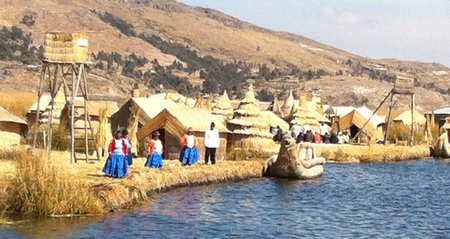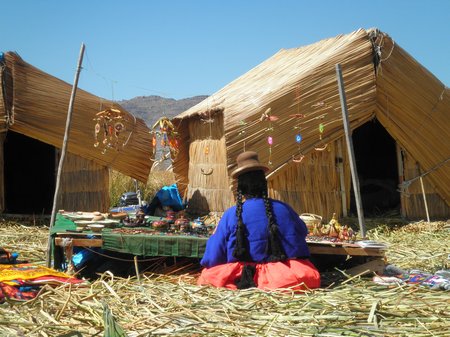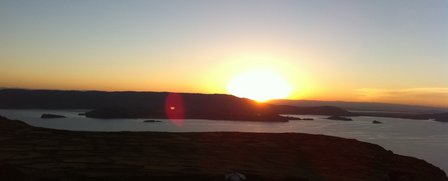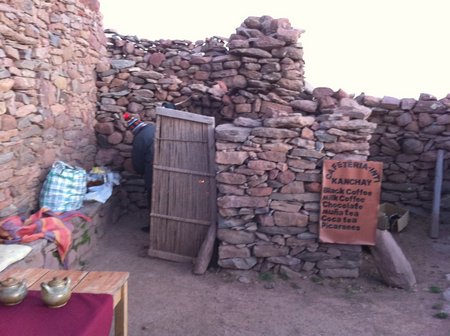A good deal of law, American or otherwise, concerns separation and division: partnerships dissolve and assets must be allocated, or marriages end in divorce and property must be divided. Modern American law has any number of mechanisms for the allocation of property between disputing parties.
The latter day descendants of the Uros people, who live (more or less) on Lake Titicaca, have developed a unique method of dealing with intra-clan disputes. The Uros constructed a network of artificial floating islands on the part of the lake near modern-day Puno, building reed huts atop a base of more reed and clay. The island that we visited measured approximately seventy by thirty feet and held about six reed huts and as many families.
Our guide described the Uros method of dispute resolution. If the clan living on the island found itself unable to resolve its internal differences, the clan would shift the huts of contending parties to opposite sides of the island, and then the clansmen would use a very large saw to cut the island itself in two. Both sides were then free to drift away from each other and start anew. As mediation goes, I suppose it does cut down on legal fees.

Our approach to the floating village
But I am getting ahead of myself....
We set out for Puno from Cuzco, our base of operations while in Peru. There are many ways to get between the two cities: flights, a highly expensive luxury rail service, and our preferred option, a bus. There are very cheap overland options, but we opted for a slightly more upscale tour bus that would stop at various historic churches and ruins along the way. None of it was particularly memorable, although there was a nice church, and had I to do it again, I probably would skip this and spend more time at the lake.
We had booked ourselves into The Point hostel in Puno. The Point wasn't bad, decently clean if somewhat run down, with bedding that had seen both recent washings and better days. If you stay there, be aware of two things. First, the food from the kitchen is very poor, with almost every recipe being some variation of starch-and-ketchup. Second, anyone walking down from the top-level bar or the third floor can see down the staircase directly into the second-floor mens' showers. I leave it to you to guess as to whether this is error or design.
But the hostel staff were more than happy to book us on an overnight "lake tour," which seems to be a backpacker specialty. We were told to be ready for an 8am pickup from the hostel with "other travelers," although the only companion from our hostel ended up being pleasant young woman from Delft. We were driven down to the docks, where we handed our vouchers to an agent who proceeded to negotiate with several boat owners. My Spanish was not up to the task of following her hurried negotiations, but it seems that these agents arrange tours with boat owners in the morning, and then phone ahead to the various islands to say how many tourists will be arriving on any given day.
The Uros and the floating islands

A woman on a reed island presents her wares
Our guide's description of real-estate based arbitration was only one of the many facts he recited to us (in very good English) about the lake, the customs of the Uros people, and the method of creating the floating islands. Apparently there has been some dispute as to whether the islands really "float," a doubt which the island headman attempted to dispel by thrusting a long pole through a slim hole in the center of the island. I was unclear about what this was supposed to prove, but whether the islands "float" or not, they remain a pretty impressive feat of engineering.
Several guidebooks complain that the reed islands have become touristy, which they certainly are, and I honestly couldn't be certain whether the particular island that we were on was an actual, working hamlet or a replica put together for tourists. But as the series of islands contain schools and a small medical center, it is unlikely that the entire set up is some form of Potemkin touristry.
Homestay, home cooking, and muna tea
After our sojourn on the Uros island, we got back on the tour boat and headed towards a nearby island, and at this point I wished I'd spent more time researching our boat instead of accepting a random assignment. About forty feet long, the engine of our water bus sat quasi-exposed under a makeshift wood box at the stern, spilling oil (and probably gasoline) into channels that ran just beneath the floorboards. Thus, the overwarm belowdecks held a disorienting bouquet of exhaust fumes and body-odor. The rooftop seating had fresh air, but became shiveringly cold once the boat left the relative shelter of the reeds along the lakeshore. Many passengers spent much of the lengthy boat trip climbing up and down like lizards that couldn't find a comfortable spot to perch.
From the top of the boat, however, Lake Titicaca is a sight to behold. On a sunny day, the deep azure water stretches away forever, and if it were not for the thin, cold air it would be easy to forget that this lake is a gigantic bowl of water 12,500 feet above sea level. Away from the shoreline and the reeds, the lake is far too deep to see the bottom, but the surface is occasionally a sporting ground for aquatic birds.
Our two-day tour included hikes along some of the local islands, which have faded more or less to a blur for me: small footpaths leading from landings to villages, each village based upon agriculture and animal husbandry. I remember distinctly, however, the first night, when we stayed at the home of a local family. Early in the afternoon, we docked on the shore of Amantani and were met by a delegation of local women ranging from young mothers to grandmothers. We were put into a group with the young lady from Delft, and our hostess led us through goatpaths and across fields to her house, where we were introduced to our host family: our hostess's father, his wife (who spoke only Quechua), our hostess's husband (albeit only later, once he was back from work) and her baby son. This last was an energetic, chubby boy who spent most of his time bouncing up and down in a playchair.
This was the point at which I most regretted the language barrier, as our minimal Spanish withstood only basic conversational gambits. We could be polite, but not effusive. But our hostess was a fine cook, turning simple ingredients into flavorful dishes. This is also where I fell in love with fresh mu�a tea, a sharp minty taste with hints of menthol. Our hostess made it by simply pouring hot water over fresh stalks pulled from her yard, and I know that I won't find that in the United States, but I am already wondering if the U.S. has a market in dried mu�a (or if I could make one).
Leaving our families, we spent the evening before dinner climbing Pachamama. Of the two peaks on the island, Pachamama is the one dedicated to the earth mother. On a good, clear day Bolivia is easily visible from the top. Ours was not a clear day, and the mist to the east obscured all but the outline of Bolivia's coast. Instead, we watched the sun set over the lake, providing an opportunity for even the most skillless photographer, armed only with an iPhone, to capture breathtaking views.

A few feet below Pachamama's peak, an alcove formed by old stone ruins almost hides my favorite coffeeshop of the trip so far. After an hour's climb in thin mountain air, a cup of coffee--even Peruvian instant Nescafe --sooths cold fingers and warms the lips. Better yet, the gentleman cooks "doughnuts" and serves them fresh from the fire. They taste like funnelcake, only better, like someone plucked your grandfather's favorite childhood memory of "how it used to be" out of the air and served it to you with honey.

If a Starbucks opens next to this guy's shop, I'm going to cry.
Returning to Cuzco
On the return trip to Cuzco, we decided to take our first overnight bus. (We would later take similar buses, on longer trips, in Argentina.) These are not at all uncomfortable, but I highly recommend upgrading to the "Super Cama," or whatever the bus company considers to be its first class seat. The difference in price is not that great and the extra leg room will be worth it. These buses feel considerably more secure than their Ecuadorian counterparts , and no one walks in or out of the bus to hawk goods during the trip.
Thinking that the overnight bus would save us having to pay for a hotel room, we made a rookie error. The best bus to take from Puno to Cuzco is the last overnight bus. Earlier departures may get you to Cuzco's bus terminal (which is not in the best part of town) at around 4 a.m., when taxi drivers will insist on charging more than twice their normal rates. A little negotiation will go a long way, but some will not negotiate, particularly if there are plenty of other potential passengers literally "just off the bus" who do not know that thirty pesos is not a good price for a cab ride to their hostel.

If a Starbucks opens next to this guy's shop, I'm going to cry.
Careful Tony, you're coming dangerously close to criticising capitalism there! ;-)